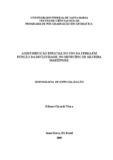| dc.contributor.advisor | Cassol, Roberto | |
| dc.creator | Viera, Ediane Girardi | |
| dc.date.accessioned | 2019-08-29T15:20:34Z | |
| dc.date.available | 2019-08-29T15:20:34Z | |
| dc.date.issued | 2009-05-18 | |
| dc.date.submitted | 2009 | |
| dc.identifier.uri | http://repositorio.ufsm.br/handle/1/18076 | |
| dc.description | Monografia (especialização) - Universidade Federal de Santa Maria, Centro de Ciências Naturais e Exatas, Curso de Especialização em Geomática, RS, 2009. | por |
| dc.description.abstract | The mapping of the earth use of a region is important for the comprehension of space and its
transformations; beyond of solving the problems resulting from the habit of development at
random, in an uncontrolled way, causing soil and agricultural earth destruction. The planning
becomes important in the economical development of the town to the restructure of devastated
areas, as well as the preservation, through studies that show the environment conditions. The
general objective of this work consists in analyzing the use of land, through the map creation;
and as specific objective to evaluate the spatial distribution of earth use with the application of
techniques by satellite imaging. In the methodology a bibliographic review was done, a basemap
was elaborated, the maps of declivity, hypsometric and the earth use, using the
cartographic and remote censoring techniques, where the instrument SPRING 4.2, generating
georeferential cartographic products. The city of Silveira Martins is characterized by the
predominance of small rural properties originated from the land occupation model of the time,
when the immigrant received a lot, totally covered by forests, being the first step, the
deforestation to the agriculture practice. The forests that represent 53% of the total area, are in
the areas of accentuated incline, allowing the agricultural practice, because it makes more
difficult the mechanization and with it, the forest areas are preserved. The field and farms
totalize 40% of the area, as the fields are located in busy areas where the topography favors
the soil erosion; in the farming, the main growing are potatoes, soy, corn, with direct planting,
with chemical fertilizer, agrotoxics. The instrument SPRING 4.2 made possible a real
representation of the variable used, allowed knowing the dynamic of the local landscape, the
hypsometric and the clinography that were important to the comprehension of the dynamic
use of the land. | eng |
| dc.language | por | por |
| dc.publisher | Universidade Federal de Santa Maria | por |
| dc.rights | Acesso Aberto | por |
| dc.rights | Attribution-NonCommercial-NoDerivatives 4.0 International | * |
| dc.rights.uri | http://creativecommons.org/licenses/by-nc-nd/4.0/ | * |
| dc.subject | Geotecnologias | por |
| dc.subject | Uso da terra | por |
| dc.subject | Declividades | por |
| dc.subject | Geografia | por |
| dc.title | A distribuição espacial do uso da terra em função da declividade, no município de Silveira Martins/RS | por |
| dc.type | Trabalho de Conclusão de Curso de Especialização | por |
| dc.degree.local | Santa Maria, RS, Brasil | por |
| dc.degree.specialization | Geomática | por |
| dc.description.resumo | O mapeamento do uso da terra de uma região é importante para a compreensão do espaço e
suas transformações; além de solucionar os problemas decorrentes do hábito do
desenvolvimento ao acaso, de maneira incontrolada, provocando, destruição dos solos e de
terras agricultáveis. O planejamento torna-se importante no desenvolvimento econômico
municipal para a reestruturação das áreas devastada, assim como a preservação, através de
estudos que demonstram as condições do meio. O objetivo geral do trabalho consiste em
analisar o uso da terra, através da geração de mapas, e como objetivo específico avaliar a
distribuição espacial do uso da terra com a aplicação de técnicas por imageamento de satélite.
Na metodologia fez-se uma revisão bibliográfica, elaborou-se o mapa base, os mapas de
declividade, hipsométrico e uso da terra, utilizando-se técnicas cartográficas e de
Sensoriamento Remoto, onde utilizou-se aplicativo SPRING 4.2, gerando produtos
cartográficos georreferenciados. O município de Silveira Martins caracteriza-se pelo
predomínio de pequenas propriedades rurais originadas do modelo de ocupação da época,
onde o imigrante recebia um lote, totalmente recoberto por florestas, sendo o primeiro passo,
o desmatamento para a prática da agricultura. As florestas que representam 53% da área total,
se encontram nas áreas de declive acentuado impossibilitando a prática da agricultura e
pecuária, pois dificulta a mecanização e com isso, as áreas de florestas são preservadas. Os
campos e lavouras totalizam 40% da área, sendo que os campos se localizam em áreas
comprometidas onde a topografia favorece á erosão do solo; na lavoura os principais cultivos
são batata inglesa, a soja, e milho, com plantio direto, com uso de adubos químicos,
fertilizantes e agrotóxicos. O aplicativo SPRING 4.2 possibilitou uma representação real das
variáveis utilizadas, permitiu conhecer a dinâmica da paisagem do local, a hipsometria e a
clinografia das quais foram importantes para compreender a dinâmica do uso da terra. | por |
| dc.publisher.country | Brasil | por |
| dc.publisher.initials | UFSM | por |
| dc.subject.cnpq | CNPQ::CIENCIAS EXATAS E DA TERRA::GEOCIENCIAS | por |
| dc.publisher.unidade | Centro de Ciências Naturais e Exatas | por |



